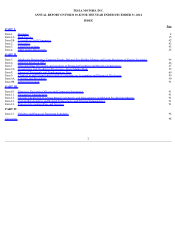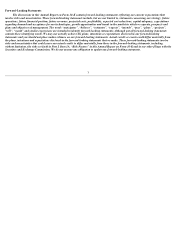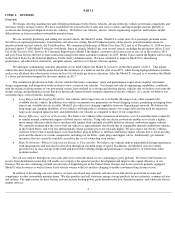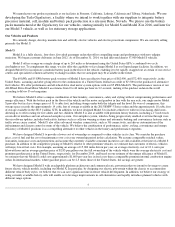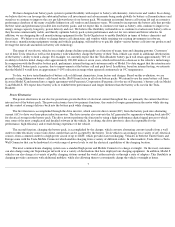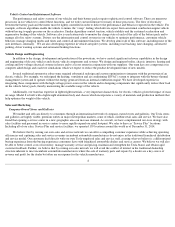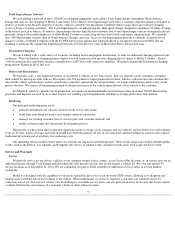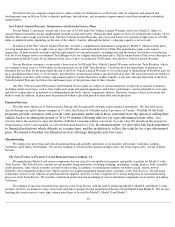Tesla 2015 Annual Report Download - page 13
Download and view the complete annual report
Please find page 13 of the 2015 Tesla annual report below. You can navigate through the pages in the report by either clicking on the pages listed below, or by using the keyword search tool below to find specific information within the annual report.
Daimler AG
Beginning in 2008, we commenced efforts on a powertrain development arrangement with Daimler. Since that time, we have developed
and produced powertrain components for Daimler for the Smart fortwo electric drive program, the A-Class electric vehicle program and the B-
Class electric vehicle program. We started to supply production parts for the B-Class electric vehicle program in 2014 and expect to continue to
supply parts under this program for the next few years.
Toyota Motor Corporation
In May 2010, we and Toyota announced our intention to cooperate on the development of electric vehicles, and for us to receive Toyota’
s
support with sourcing parts and production and engineering expertise for Model S. Since that time, we have developed and produced a validated
powertrain system, including a battery, power electronics module, motor, gearbox and associated software, which was integrated into an electric
vehicle version of the Toyota RAV4. We began delivery of these systems to Toyota for installation into the Toyota RAV4 EV in the first half of
2012. During the third quarter of 2014, we completed the RAV4 EV program.
Governmental Programs, Incentives and Regulations
Full Repayment of United States Department of Energy Loans
In May 2013, we paid $451.8 million to settle all outstanding loan amounts due under a loan facility we had entered into with the Federal
Financing Bank (FFB) and the United States Department of Energy (DOE), under the DOE’s Advanced Technology Vehicles Manufacturing
Loan Program, as set forth in Section 136 of the Energy Independence and Security Act of 2007 (ATVM Program). We refer to the loan facility
with the DOE as the DOE Loan Facility.
Under the DOE Loan Facility, the FFB had made available to us two multi-draw term loan facilities in an aggregate principal amount of
$465.0 million beginning on January 20, 2010. As of August 31, 2012, we had fully drawn down the aforementioned facilities. On May 22,
2013, we paid $451.8 million to fully retire our obligations under the DOE Loan Facility.
In connection with the closing of the DOE Loan Facility, we had also issued a warrant to the DOE to purchase up to 9,255,035 shares of
our Series E convertible preferred stock at an exercise price of $2.51 per share. Upon the completion of our initial public offering on July 2,
2010, this preferred stock warrant became a warrant to purchase up to 3,090,111 shares of common stock at an exercise price of $7.54 per share.
As a result of our repayment of all outstanding principal and interest under the DOE Loan Facility and the termination of the DOE Loan Facility
in May 2013, the DOE warrant expired. Additionally, we amortized all remaining unamortized debt issuance costs related to the DOE Loan
Facility.
California Alternative Energy and Advanced Transportation Financing Authority Tax Incentives
In
December 2009, we finalized an arrangement with the California Alternative Energy and Advanced Transportation Financing Authority
(CAEATFA) that resulted in an exemption from California state sales and use taxes for the purchase of $320 million of manufacturing
equipment. As the equipment purchased would otherwise have been subject to California state sales and use tax, we believe this incentive
resulted in tax savings by us of approximately $31 million over the period starting in December 2009 and ending in December 2013. The
equipment purchases were used for three purposes: (i) to establish our production facility for Model S in California, (ii) to upgrade our Palo Alto
powertrain production facility, and (iii) to expand our Tesla Roadster assembly operations at our Menlo Park facility. We exhausted all funds
from the December 2009 approved exemption from California state sales and use taxes for $320 million of manufacturing equipment in
December 2013.
In January 2012, we finalized an additional agreement with CAEATFA for an exclusion from California state sales and use taxes for the
purchase of up to $292 million of manufacturing equipment. To the extent all of this equipment is purchased and would otherwise be subject to
California state sales or use tax, we believe this incentive would result in tax savings by us of up to approximately $24 million over the period
starting in December 2011 and ending in December 2015. The equipment purchased under this exclusion may only be used for two purposes:
(i) to develop Model X and its production capacity in California and (ii) to further upgrade our powertrain production facilities in California. We
have not yet exhausted the $292 million in funds approved by CAEATFA in 2012.
In December 2013, we finalized a third agreement with CAEATFA that will result in an exclusion from California state sales and use
taxes for an additional $415 million of manufacturing equipment. To the extent all of this equipment is purchased and would otherwise be
subject to California state sales or use tax, we believe this 2013 incentive would result in tax savings by us of up to approximately $35 million
over the period starting in December 2013 and ending in December 2016. The equipment purchased under this exclusion may only be used for
three purposes: (i) to expand Model S manufacturing capacity in California; (ii) to expand electric vehicle powertrain production in California;
and (iii) future Model S electric vehicle development.
12


